Are you having small red itchy bumps and rashes on your skin? You may have been affected by a condition called Folliculitis. Read on and know all about Folliculitis – what is Folliculitis, what causes Folliculitis, what are the symptoms of Folliculitis and more.
Folliculitis Definition
Page Contents
- 1 Folliculitis Definition
- 2 Types of Folliculitis
- 3 Folliculitis Symptoms
- 4 Folliculitis Causes
- 5 Folliculitis Treatment
- 6 Folliculitis Pictures
- 7 What Does Folliculitis Look Like?
- 8 Recurrent Folliculitis
- 9 Scalp Folliculitis
- 10 What is Folliculitis Decalvans?
- 11 Is Folliculitis Contagious?
- 12 What is Malassezia Folliculitis?
- 13 Is Folliculitis Infectious?
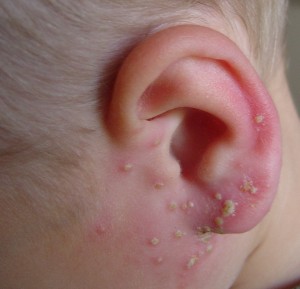
Photo 1 – Folliculitis
Source – skindisordersguide
Folliculitis is a health condition that involves the swelling of one or more follicles of the hair. The disease may strike any part of the skin. It commonly affects areas of the body like scalp, face, cheeks, neck, arms, armpits, chest, back, groin, genital region and legs. One can also have Folliculitis on buttocks. The only areas that remain unaffected by Folliculitis are the palms and soles of the body.
Types of Folliculitis
Depending on the intensity of symptoms, Folliculitis is classified into two types :
Superficial Folliculitis
It affects the external surface of the body. In Superficial Folliculitis, rashes and papules develop on the skin surface in any area of the body except the palms and soles.
Superficial Folliculitis itself can be of different subtypes, such as :
Bacterial Folliculitis
It results from a bacterial infection, mainly of the Staphylococcus bacteria variety. A Staphylococcal Folliculitis arises due to infection from a blunt blade while shaving. An infection by the Pseudomonas bacteria can lead to Pseudomonas Folliculitis, also known as Hot Tub Folliculitis. A person usually gets it from hot wooden tubs and develops red itchy lumps within a day after exposure.
Fungal Folliculitis
It arises when fungus or yeast infects the deeper layers of the hair follicles or the skin. Tinea barbae is a well known Fungal Folliculitis. Tinea Folliculitis Barbae can result in pus-filled, deep red bumps on any part of the body.
Viral Folliculitis
It is caused by a viral infection, mainly by the Herpes Simplex Virus (HSV).
Parasitic Folliculitis
This occurs when small, parasitic micro-organisms nest themselves into the hair follicle and lay eggs there.
Deep Folliculitis
In this condition, the infection extends deep into the hair follicle and affects either the entire follicle or a deeper area of the follicle.
Deep Folliculitis can also be subdivided into various subtypes like :
Gram Negative Folliculitis
This happens in people who use antibiotics for a long time for acne treatment. Antibiotics disrupt the normal bacterial balance in the body and result in profusion of harmful organisms.
Eosinophilic Folliculitis
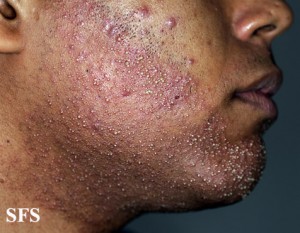
Photo 2 – Eosinophilic Folliculitis Picture
Source – paraorkut
It is generally visible in people who are affected by HIV infection. It is also known as Eosinophilic Pustular Folliculitis.
Deep Bacterial Folliculitis
This occurs when there is deep infection of the hair follicles by the Staphylococcus bacteria. It leads to boils and carbuncles on various regions of the skin surface.
Folliculitis Symptoms
The main symptoms of Folliculitis are :
Itchiness
People affected with Folliculitis commonly suffer from itchiness in one or more parts of the body. Folliculitis on penis is especially discomforting.
Rashes
Folliculitis sufferers are often seen to suffer from rashes. Rashes may arise on any part of the body covered with skin, except the palms and soles.
Pimples
Small reddish pimples or pustules can arise close to hair follicle in regions like face, neck, groin and genital. Pustular Folliculitis can be very discomforting for affected people.
Swollen Bumps
Inflamed lumps can arise on the skin of Folliculitis patients. These can be hot and painful to touch. In later stages, a head is formed over these boils and can burst to release pus from within.
Folliculitis Causes
Some of the main causes of Folliculitis are :
Damage of Hair Follicles
Folliculitis can arise if one or more hair follicles suffer damage during shaving, due to friction with a piece of clothing or due to obstruction because of a skin trauma or some other reason. If people with curly hairs trim their scalp hair or beard too short, the hair may curve and grow into the skin causing inflammation and Folliculitis.
Bacterial Infection
Infection by the Staphylococcus Aureus bacteria or overgrowth of the Gram-negative bacteria can be a major reason behind Folliculitis.
Fungal Infection
An infection by the Malassezia furfur fungus gives rise to Pityrosporum Folliculitis, a kind of Superficial Folliculitis.
Viral Infection
An infection by the Herpes Simplex Virus (HSV) can cause Herpetic Folliculitis, a type of Superficial Folliculitis.
Parasitic Infection
Parasite infection is a main cause of Deep Folliculitis. It happens when parasites infect and lay eggs at the hair follicles.
Folliculitis Treatment
Folliculitis usually goes away within a week. However, infectious cases of this condition can be really painful and discomforting for the sufferer. Mild cases can be treated at home with antibacterial mouthwash, soaps, antibiotic ointments and over the counter medicines. For serious cases, oral antibiotic drugs and Laser Hair Removal Method are used for Folliculitis treatment.
Folliculitis Pictures
Confused whether you are suffering from Folliculitis or not? Check out these pictures of Folliculitis. These Folliculitis photos will help you get a visual idea about the disease and find out whether you are having Folliculitis rashes on your skin. Here are also some Pityrosporum Folliculitis pictures that you will find useful.
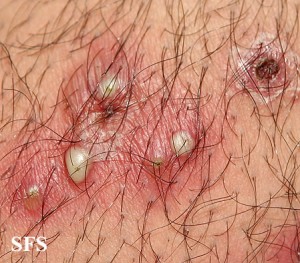
Image 3 – Folliculitis Picture
Source – healthhype
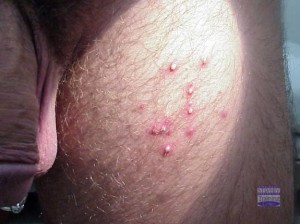
Image 4 – Folliculitis Photo
Source – uc.edu
What Does Folliculitis Look Like?
Folliculitis rashes are usually red and swollen in appearance. These can arise almost anywhere on the human body. In some cases, the rashes can develop into a boil filled with pus. The boils develop a head which may burst after sometime to discharge pus.
Recurrent Folliculitis
Folliculitis can often come back and cause complications. Recurring Folliculitis occurs in people who have a bacterial infection in their nose. In case of a Recurrent Folliculitis, infection can spread into the deeper areas of the body. Frequent recurrence of Folliculitis can lead to formation of scars on the skin surface. In case of Folliculitis on scalp, it can result in permanent Folliculitis hair loss. Mild Folliculitis does not recur.
Scalp Folliculitis
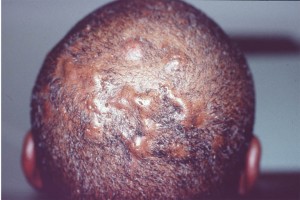
Picture 5 – Scalp Folliculitis
Source – cdlib
Folliculitis of the scalp usually happens when excess oil obstructs the sebaceous glands and gives rise to itchiness and swollen bumps on the skin of the head. It can also arise due to hair follicle infection by bacteria, mites and yeast. Staphylococcus bacterium and Propionibacterium acnes are the two main bacteria responsible for a Folliculitis scalp.
What is Folliculitis Decalvans?
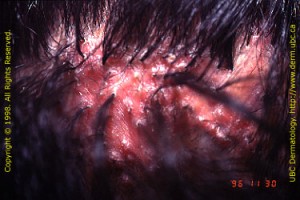
Picture 6 – Folliculitis Decalvans
Source – dermatology
This is an inflammatory condition that mainly affects the scalp and leads to a loss of hair. This can strike any part of the scalp and spread to other parts. It can result in sores and scarring on the scalp and hair loss.
Is Folliculitis Contagious?
Folliculitis in general is not contagious. But certain types of the disease are. Staphylococcal Folliculitis is highly contagious. This condition, caused by bacterial infection, spreads by direct skin- to-skin contact. Sharing towels, razors, clothes or undergarments can also transmit the disease.
What is Malassezia Folliculitis?
It is a kind of Folliculitis resulting from a Malassezia yeast infection. It can give rise to papules and lesions on areas like the upper arms, neck, chest and back. They are rarely seen on the face.
Is Folliculitis Infectious?
Folliculitis can be infectious as well as non-infectious. Infectious Folliculitis is more common than the non- infectious one. Infectious Folliculitis arises from hair damage caused by shaving, friction with clothing, injuries and the like.
If you are suffering from Folliculitis and the symptoms refuse to subside even 3 days after use of home remedies and treatment over the counter drugs, you must call up a doctor. Professional medical care will help you recover from the condition faster and avoid all complications including infection in future.
References:
http://www.ncbi.nlm.nih.gov/pubmedhealth/PMH0001826/
http://en.wikipedia.org/wiki/Folliculitis
http://www.medicinenet.com/folliculitis/article.htm
http://emedicine.medscape.com/article/1070456-overview
http://www.nlm.nih.gov/medlineplus/ency/article/000823.htm
http://www.wrongdiagnosis.com/f/folliculitis/intro.htm

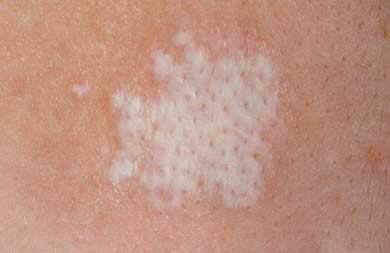
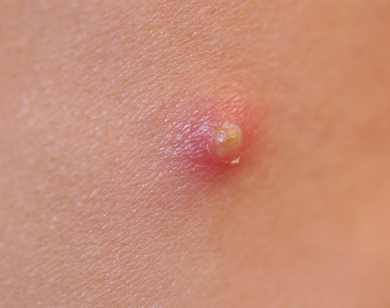
My husband layed sod in our backyard last night and today has this rash on his knees. It is red with pus filled pimple looking blisters…looks just like the picture above. has anyone ever heard of this and how do you know if it is bacterial, fungal, or parasitic. If he got something from the sod it could have been any of those three and how do you know if it is infectious or non infectious. I dont want myself or kids to get it!